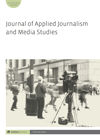
Full text loading...

 , Md Azalanshah Md Syed1
, Md Azalanshah Md Syed1
Audiences’ shifts to online and interactive engagement have posed numerous challenges to Bangladesh’s media ecology. This descriptive case study examines the current state of digital transition, complexities and competitions faced by the local television industry by putting Ntv Online, one of the first-generation television station’s online portals and convergence pioneers, at the centre of the discussion. It explains how Ntv Online is internalizing and responding to convergence practice from both media market dynamics and organizational perspectives. This study believes that issues other than those raised by media technology are equally important in comprehending the digital transition of Bangladesh’s television industry. The key findings indicate that the hybrid regime’s intervention in free media practices as well as complex market competition from massive tech platforms limit Bangladesh’s trajectory as a competitor in the global digital media arcade. This also implies that existing ownership and corporate structures may not support the required interoperability between management and journalists. However, the digital transitions of the private TV industry may pave the way for the creation of a democratic space for public deliberation, which is essentially demanded in the current hybrid regime’s intervention in actualizing this shift.

Article metrics loading...

Full text loading...
References

Publication Date:
https://doi.org/10.1386/ajms_00097_1 Published content will be available immediately after check-out or when it is released in case of a pre-order. Please make sure to be logged in to see all available purchase options.